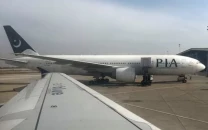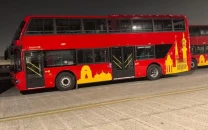Items of dual use: Of dirty laundry and spilled milk, nations and their shame
Group show brings together Swedish and Pakistani artists.

A wide space at the VM Art Gallery is exhibiting a group show of two Pakistani artists, Ayesha Jatoi and Muzzumil Raheel, and two Swedish artists, Lina Persson and Henrik Andersson, titled ‘Items of Dual Use.’
As the second day of the exhibition opened with stills, video images and structures of fighter planes placed across the room, there were a few people present to appreciate the brilliant art work. VM Gallery’s manager, Riffat Ali, said that people flowed into the opening. “But the cricket matches made it tough to pull in visitors for the next few days,” she shrugged.
The show’s curator, Waheeda Baloch, said the project is a way of looking at the private and public world and the synergy between the two. She is currently studying for a curatorial masters at Stockholm University.
Waheeda referred to a piece titled ‘Clothesline’ by Ayesha Jatoi, which showed a fighter jet with red laundry clothes on top of it.
“In our society where honor, shame and privacy are fiercely guarded, clothes put out to dry, outside the homes, give us a peak into what the people inside the homes are all about,” said the curator.
Similarly, public places give us insight into the sort of people living in the country or city. “Rather than erecting statues of great thinkers, liberals or heroes, we are more concerned about erecting missiles and fighter planes at public intersections,” said Baloch. She spoke of a similar tribute to violence at ‘China Chowk’, where a fighter jet used in the 1971 war is mounted. According to Baloch, this became not only a source of pride but also one of shame since “in a way it was the nation’s dirty laundry on full display.”
Items of dual use refers to objects which may be used for military or civil purposes and in this case also applies to some advanced technologies, which are to be exported. Thus, it was not strange to find weapons, representing violence and barbarianism, and items of daily use such as clothes displayed side by side.
Though Lina was not present at the time, her calligrams titled ‘Spilled Milk of Haunted Nations’ were explained by the curator. “It is a criticism of the western media that misuses the freedom of expression.”
Images can also be a weapon that cause harm, bring turmoil and distress in a society, especially when the media is busy exploiting images to suit their purposes. “A prime example is when Danish editors chose to publish the images of Prophet Muhammad (pbuh), knowing that it would provoke Muslims. But what they did not know was that it would cause Denmark a $7.5-billion loss because of the boycott of Danish products.”
Baloch pointed out that Henrik has created a conceptual piece by submitting a request to the Swedish trade council for the export of the artworks to Pakistan. Henrik said he was surprised to find that the shirt he wore, during his voluntarily military services as a drafted serviceman, was made in Pakistan. He brought it along to display as a totem of intercultural exchange.
Published in The Express Tribune, April 1st, 2011.



















COMMENTS
Comments are moderated and generally will be posted if they are on-topic and not abusive.
For more information, please see our Comments FAQ